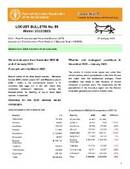General situation during August 2023 Forecast for September 2023
While the locust campaign is approaching the end, the situation was still classified as caution for Moroccan (DMA), Italian (CIT) and Asian Migratory Locusts (LMI) in the Russian Federation, for LMI in Kazakhstan and CIT in Kyrgyzstan. It was calm in other countries and for...
General Situation during July 2023 Forecast for August 2023
Moroccan Locust (DMA) natural cycle completed in all Caucasus and Central Asian (CCA) countries while mating and egg-laying continued in the Russian Federation. The Italian Locust (CIT) and the Asian Migratory Locust (LMI) started mating and egg-laying in CCA. The situation with DMA was considered dangerous only...
General Situation during June 2023 Forecast for July 2023
Moroccan Locust (DMA) lifecycle came to an end in most parts of Central Asia (CA); fledging, mating and egg-laying continued in some parts as well as in Caucasus. Due to increased number of DMA populations and large spread of adults in the south of the Russian Federation, the situation there...
General Situation during May 2023 Forecast for June 2023
Moroccan Locust (DMA) fledging, mating and egg
laying started in most areas of Central Asia (CA), with swarm flights, including across borders, reported in southern parts. The situation was critical in Afghanistan and Tajikistan in...
General Situation during April 2023 Forecast for May 2023
Moroccan Locust (DMA) hatching and hopper development was in progress in all Central Asian (CA) countries as well as in Azerbaijan and in Georgia. Critical situation in several north and north-east provinces of Afghanistan and south of Tajikistan was reported. Italian Locust (CIT) hatching had been recorded only in southern...






